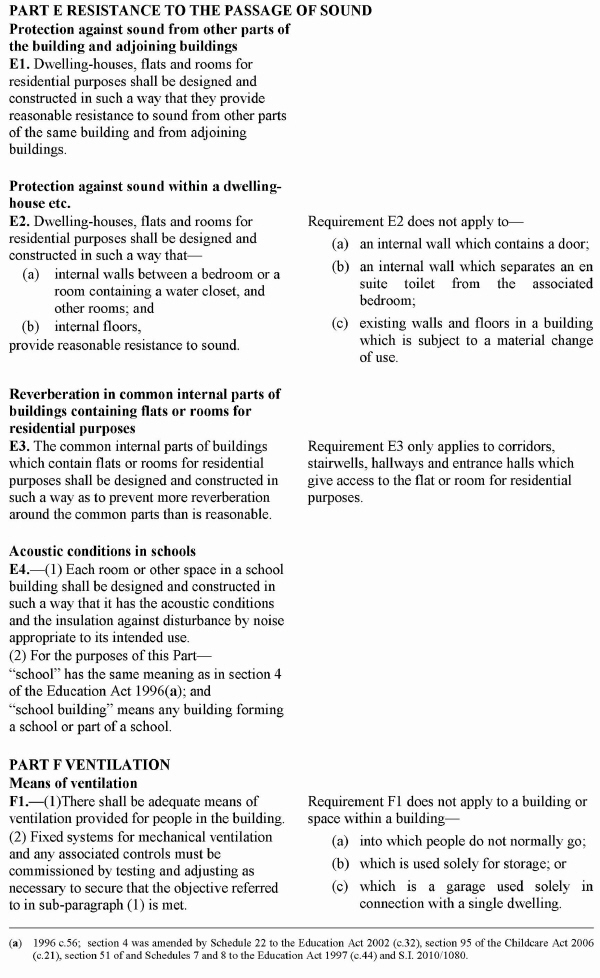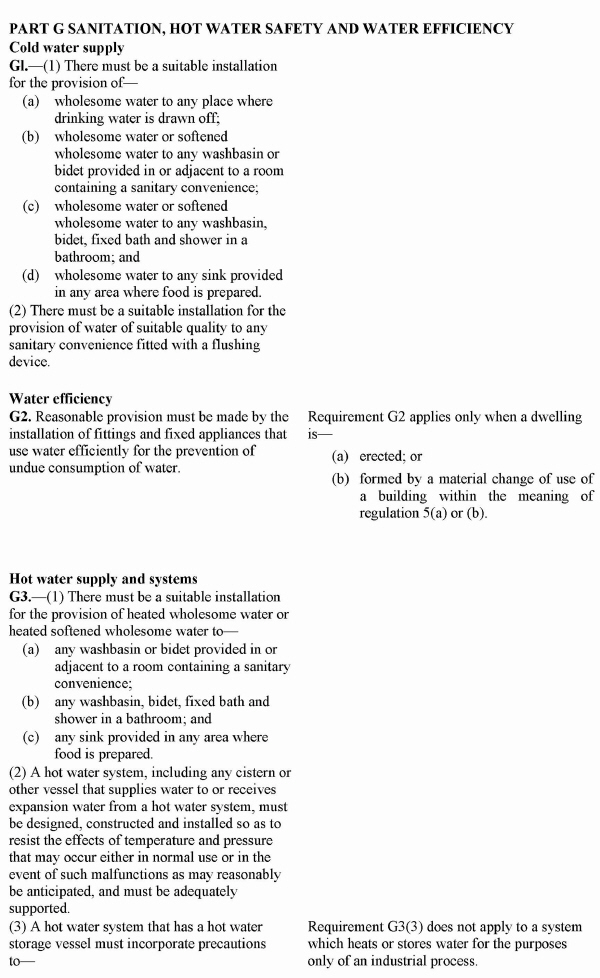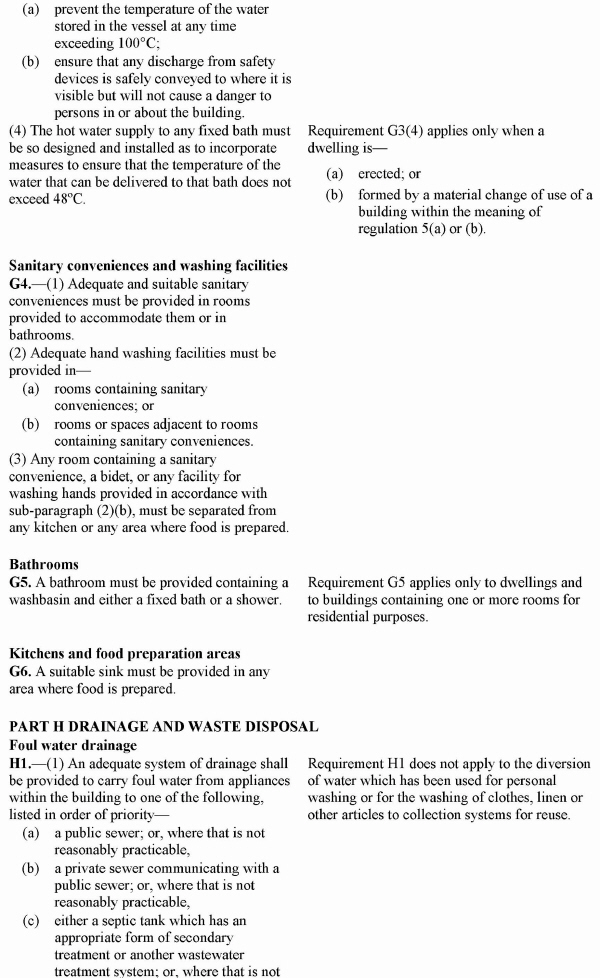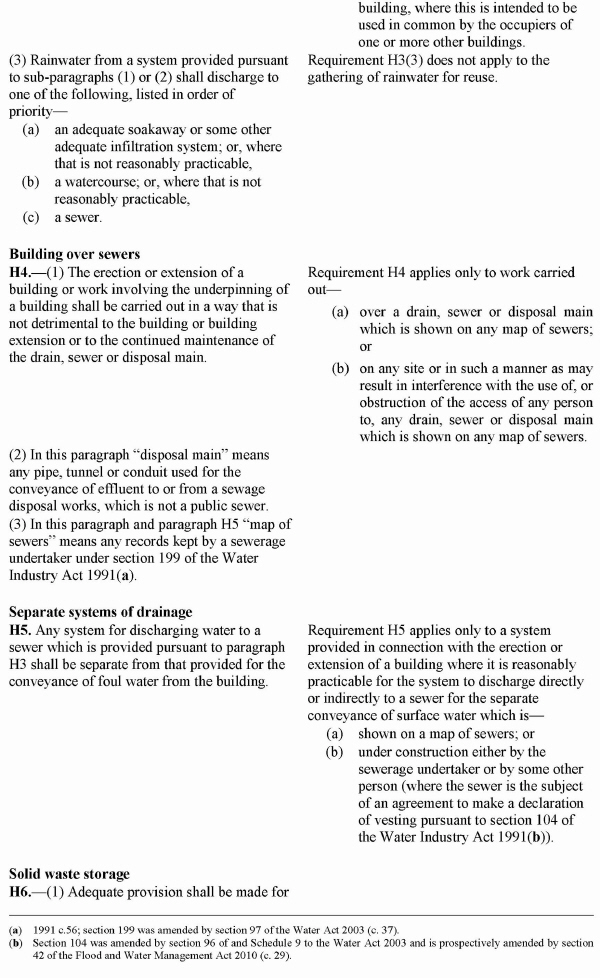
Print Options
PrintThe Whole
Instrument
PrintThis
Schedule
only
Changes over time for: SCHEDULE 1


Timeline of Changes
This timeline shows the different points in time where a change occurred. The dates will coincide with the earliest date on which the change (e.g an insertion, a repeal or a substitution) that was applied came into force. The first date in the timeline will usually be the earliest date when the provision came into force. In some cases the first date is 01/02/1991 (or for Northern Ireland legislation 01/01/2006). This date is our basedate. No versions before this date are available. For further information see the Editorial Practice Guide and Glossary under Help.
Version Superseded: 01/10/2015
Status:
Point in time view as at 06/04/2013.
Changes to legislation:
The Building Regulations 2010, SCHEDULE 1 is up to date with all changes known to be in force on or before 19 May 2025. There are changes that may be brought into force at a future date. Changes that have been made appear in the content and are referenced with annotations.

Changes to Legislation
Changes and effects yet to be applied by the editorial team are only applicable when viewing the latest version or prospective version of legislation. They are therefore not accessible when viewing legislation as at a specific point in time. To view the ‘Changes to Legislation’ information for this provision return to the latest version view using the options provided in the ‘What Version’ box above.
Regulations 4 and 6
SCHEDULE 1E+WRequirements
This schedule has no associated Explanatory Memorandum










[PART K PROTECTION FROM FALLING, COLLISION AND IMPACT
| Stairs, ladders and ramps |
|---|
K1. Stairs, ladders and ramps shall be so designed, constructed and installed as to be safe for people moving between different levels in or about the building.
| Requirement K1 applies only to stairs, ladders and ramps which form part of the building.
|
| Protection from falling |
|---|
K2. (a) Any stairs, ramps, floors and balconies and any roof to which people have access, and
(b) any light well, basement area or similar sunken area connected to a building,
shall be provided with barriers where it is necessary to protect people in or about the building from falling.
| Requirement K2(a) applies only to stairs and ramps which form part of the building.
|
| Vehicle barriers and loading bays |
|---|
K3.—(1) Vehicle ramps and any levels in a building to which vehicles have access, shall be provided with barriers where it is necessary to protect people in or about the building.
(2) Vehicle loading bays shall be constructed in such a way, or be provided with such features as may be necessary to protect people in them from collision with vehicles.
| |
| Protection from collision with open windows etc |
K4. Provision shall be made to prevent people moving in or about the building from colliding with open windows, skylights or ventilators.
| Requirement K4 does not apply to dwellings.
|
| Protection against impact from and trapping by doors |
|---|
K5.—(1) Provision shall be made to prevent any door or gate—
(a) which slides or opens upwards, from falling onto any person; and
(b) which is powered, from trapping any person.
(2) Provision shall be made to ensure a clear view of the space on either side of a swing door or gate.
| Requirement K5 does not apply to—
(b) any door or gate which is part of a lift.]
|
[PART K PROTECTION FROM FALLING, COLLISION AND IMPACT
| Stairs, ladders and ramps |
|---|
| K1. Stairs, ladders and ramps shall be so designed, constructed and installed as to be safe for people moving between different levels in or about the building. | Requirement K1 applies only to stairs, ladders and ramps which form part of the building. |
| Protection from falling |
|---|
K2. The following shall be provided with barriers where it is necessary to protect people in or about the building from falling—
(a) any stairs, ramps, floors and balconies and any roof to which people have access, and
(b) any light well, basement area or similar sunken area connected to a building.
| Requirement K2(a) applies only to stairs and ramps which form part of the building. |
| Vehicle barriers and loading bays |
|---|
K3.—(1) Vehicle ramps and any levels in a building to which vehicles have access, shall be provided with barriers where it is necessary to protect people in or about the building.
(2) Vehicle loading bays shall be constructed in such a way, or to be provided with such features, as may be necessary to protect people in them from collision with vehicles.
| |
| Protection against impact with glazing | |
K4. Glazing, with which people are likely to come into contact while moving in or about the building, shall—
(a) if broken on impact, break in a way which is unlikely to cause injury; or
(b) resist impact without breaking; or
(c) be shielded or protected from impact.
| |
| Protection from collision with open windows etc. |
|---|
| K5.1. Provision shall be made to prevent people from moving in or about the building from colliding with open windows, skylights or ventilators. | Requirement K5.1 does not apply to dwellings. |
| Manifestation of glazing |
|---|
| K5.2. Transparent glazing with which people are likely to come into contact while moving in and about the building, shall incorporate features which make it apparent. | Requirement K5.2 does not apply to dwellings. |
| Safe opening and closing of windows etc. |
|---|
| K5.3. Windows, skylights and ventilators which can be opened by people in or about the building shall be so constructed or equipped that they may be opened, closed or adjusted safely. | Requirement K5.3 does not apply to dwellings. |
| Safe access for cleaning windows etc. |
|---|
| K5.4. Provision shall be made for any windows, skylights or translucent walls, ceilings or roofs to be safely accessible for cleaning. | Requirement K5(4) does not apply to—
(b) any door or gate which is part of a lift.
|
| Protection against impact from trapping by doors |
|---|
K6.—(1) Provision shall be made to prevent any door or gate—
(a) which slides or opens upwards, from falling onto any person; and
(b) which is powered, from trapping any person.
(2) Provision shall be made for powered doors and gates to be opened in the event of a power failure.
(3) Provision shall be made to ensure a clear view of the space on either side of a swing door or gate.
| Requirement K5(4) does not apply to—
(b) any door or gate which is part of a lift.]
|


[PART N GLAZING—SAFETY IN RELATION TO IMPACT, OPENING AND CLEANING
| Protection against impact |
|---|
N1. Glazing, with which people are likely to come into contact whilst moving in or about the building shall—
(a) if broken on impact, break in a way which is unlikely to cause injury; or
(b) resist impact without breaking; or
(c) be shielded or protected from impact.
| |
| Manifestation of glazing |
|---|
N2. Transparent glazing, with which people are likely to come into contact while moving in or about the building, shall incorporate features which make it apparent.
| Requirement N2 does not apply to dwellings.
|
| Safe opening and closing of windows etc |
|---|
N3. Windows, skylights and ventilators which can be opened by people in or about the building shall be so constructed or quipped that they may be opened, closed or adjusted safely.
| Requirement N3 does not apply to dwellings.
|
| Safe access for cleaning windows etc |
N4. Provision shall be made for any windows, skylights, or ay transparent or translucent walls, ceilings or roofs to be safely accessible for cleaning.
| Requirement N4 does not apply to—
(b) any transparent or translucent elements whose surfaces are not intended to be cleaned.]
|
Back to top














